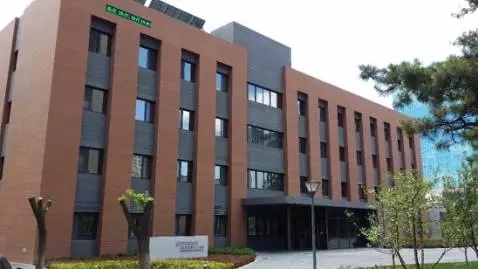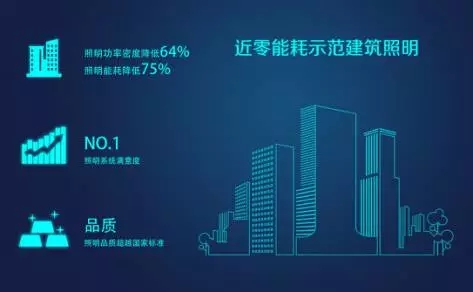On March 23, Philips Lighting announced today the operation of the smart connected lighting system in China's first near-zero energy demonstration building.
Located in the China Academy of Building Research, the building is a smart office building with high security, high connectivity and future-oriented. In this building, which is the first to practice Philips PoE (Power over Ethernet) smart connected office lighting system in the country, employees can personalize the workspace according to individual needs.
The near zero energy demonstration building located in the China Academy of Building Research (CABR) in Beijing is a four-story office building with a building area of ​​4,025 square meters. The demonstration building not only uses energy-saving LED lamps, advanced lighting control systems, but also uses PoE smart connected office lighting technology for the first time in China.
This technology provides employees with a more comfortable and efficient working environment. With the app on your smartphone, employees can personalize the level of light and shade.

Philips PoE Smart Interconnected Office Lighting System Helps China's First Near Zero Energy Demonstration Building - Building Exterior
“Ubiquitous lighting is at the heart of the Internet of Things. Smart connected lighting systems with rich sensors have been integrated into the information network of the entire building. Advanced lighting systems not only help save energy, increase productivity, but also allow employees to work. More convenient and flexible," said Wang Wei, president of Philips Lighting Greater China.

Philips PoE Smart Connected Office Lighting System Helps China's First Near Zero Energy Demonstration Building – Interior Design
Two years after the demonstration building was put into operation, the China Academy of Building Technology recently announced its operational data.
Compared with other energy-consuming systems, Philips Lighting's PoE smart connected office lighting system cooperates with LED lighting and back-end lighting control system to show its strong overall lighting service quality, user satisfaction and energy consumption. support.
The successful operation of this project indicates that the intelligent connected lighting system will play a major role in the future construction of office space.
According to the operational data from June 2014 to September 2016, the energy consumption of lighting accounts for only 16% of the energy consumption of the demonstration building. The energy consumption per unit area of ​​the building is 6.12 kWh/(m2.a), only It is one-fourth of the same kind of building, which is much lower than the standard of 40-50 kWh/(m2.a) per square meter of lighting per year in Beijing 5A office building.
The lighting power density in the demonstration building is as low as 5.5 W/m2, which is 64% lower than the current value. In 2015, the lighting system coordinated HVAC operation energy consumption was 21.6 kWh/(m2.a), which was 13.7% lower than the design target of 25 kWh/(m2.a).

Philips PoE Smart Interconnected Office Lighting System Helps China's First Near Zero Energy Demonstration Building - Infographic
“Energy saving is not the ultimate goal of near-zero energy demonstration buildings,†said Zhao Jianping, deputy dean of the Institute of Architecture and Environmental Energy Research of the China Academy of Building Research. “We attach great importance to lighting quality. We always put the lighting needs and experience of our employees. Put it first."
The adoption of Philips Smart Interconnected Lighting System highlights the emphasis on innovation, marking a solid step forward for China's office buildings to be sustainable, and the demonstration building is thus based on the forefront of future office buildings.
This coincides with the people-oriented philosophy that Philips Lighting has always upheld. According to the user satisfaction survey conducted by the China Academy of Building Research, the satisfaction of the lighting system of the near zero energy demonstration building reached 100%.

Dimmer can bring more exposure means for your creation, turn day into night and give full play to your creative space; In many cases, due to the external light intensity, we can't get a long enough shutter time, so we can't realize our photography intention. For example, when shooting water flow in the field, we want to use a 1-second shutter to make the water flow show a cotton like soft texture. However, due to the strong light, that is, shooting with the minimum aperture and minimum ISO of the camera, the shutter speed is still about 1 / 30 second. At this time, the only way is to use one or even two nd8 lenses to reduce the light entering the lens. There is a simple formula. Assuming that the shutter speed of normal exposure of your camera is t without adding a dimmer, then after adding a dimmer, under the same light conditions, aperture size and ISO, the shutter speed of normal exposure = t * x, and this x is the number marked on the rear surface of the dimmer lens. For ND4, x = 4, and for nd8, x = 8. Due to process reasons, the greater the coefficient behind nd, the greater its influence on color temperature.
Nd Filter,Nd Lens Filter,Camera Nd Filter,Square Nd Filter
shaoxing shangyu Tianya Photographic Equipment Factory , https://www.tianyafoto.com